Distributed Active Power Optimal Dispatching of Wind Farm Cluster Considering Wind Power Uncertainty
Abstract
:1. Introduction
- Based on the wake effect, we deduced the distribution characteristic model of the active power output of each wind farm by using the statistical fitting method and introducing the impulse function.
- We considered the correlation between power shortages and curtailed wind volume and established a stochastic optimization model for WFC scheduling to improve wind power consumption capacity.
- We improve the ADMM to decouple the model in space and time and solve the parallel iteration problem and design a power information interaction module to solve the problem of simultaneous decoupling between a large number of decision variables.
2. Active Power Dispatching Model of WFC Considering Wind Speed Uncertainty
2.1. Probability Density Model of Active Power Output of Wind Farm Based on Wake Effect
2.2. Active Power Scheduling Model of WFC
- When the actual output of the wind farm is greater than the dispatch command, it is in the “power saturation mode”, and the wind farm needs to take power curtailment measures at this time.
- When the actual output of the wind farm is equal to the dispatch command, it is in the “power balance mode”, which is the ideal dispatch state.
- When the actual output of the wind farm is less than the dispatch command, it is in “power shortage mode”, and the wind farm’s output is not enough to meet the dispatch command.
Objective Function and Constraints
- Scheduling plan value constraints:
- Wind farm output power limit constraints:
- Substation capacity constraints:
- Transmission line capacity constraints:
- Wind farm output power ramp constraints:
- Wind farm regulation capacity constraints:where is scheduling instructions for WFC; is the wind farm forecast power cap; and are the minimum output and installed capacity of the wind farm, respectively; and are the minimum and maximum transmission powers of the substation, respectively; is the maximum transmission power of the line; and are maximum ascent rate and maximum descent rate of wind farm active output; b is the drop-out force control ratio.
3. Distributed Model for Active Power Scheduling of WFC
3.1. A Spatiotemporal Decoupling Model for Optimal Scheduling of WFC
3.2. Distributed Optimization Algorithm Based on ADMM
3.3. Model Solving
4. Case Analysis
4.1. Optimization Results and Analysis
4.2. ADMM Testing and Analysis
4.2.1. Effectiveness Test
4.2.2. Convergence Test
4.2.3. Efficiency Test
5. Conclusions
- (1)
- The active power output probability density characteristic model of wind farms considering the uncertainty of wind power can reduce the power shortage of wind power dispatching and improve the utilization rate of wind power. The results show that the model has a 3–7% reduction in dispatched power shortfalls and a 4–21% improvement in wind power utilization. It shows that under the influence of wind power uncertainty, considering the probability density characteristics of wind power is also an effective method to improve the utilization rate of wind power.
- (2)
- When solving a large-scale WFC scheduling model with the disaster of dimensionality problem, when the number of wind farms is greater than eight, the distributed dispatching method based on ADMM has extremely high computational efficiency. When the update step size is taken to an appropriate value, it has good convergence characteristics and has better advantages than centralized dispatching.
- (3)
- The active power distributed dispatching method of WFC proposed in this paper can not only meet the needs of parallel solution of each module unit, but also improve the ability of large-scale wind power to participate in grid dispatching.
Author Contributions
Funding
Institutional Review Board Statement
Informed Consent Statement
Data Availability Statement
Conflicts of Interest
References
- Jadidi, S.; Badihi, H.; Zhang, Y. Fault-Tolerant Cooperative Control of Large-Scale Wind Farms and Wind Farm Clusters. Energies 2021, 14, 7436. [Google Scholar] [CrossRef]
- Padinharu, D.K.K.; Li, G.J.; Zhu, Z.Q.; Clark, R.; Thomas, A.; Azar, Z.; Duke, A. Permanent Magnet Vernier Machines for Direct-Drive Offshore Wind Power: Benefits and Challenges. IEEE Access 2022, 10, 20652–20668. [Google Scholar] [CrossRef]
- Vali, M.; Petrović, V.; Pao, L.Y.; Kühn, M. Model Predictive Active Power Control for Optimal Structural Load Equalization in Waked Wind Farms. IEEE Trans. Control. Syst. Technol. 2022, 30, 30–44. [Google Scholar] [CrossRef]
- Liu, Y.; Qiao, Y.; Han, S.; Xu, Y.; Geng, T.; Ma, T. Quantitative Evaluation Methods of Cluster Wind Power Output Volatility and Source-Load Timing Matching in Regional Power Grid. Energies 2021, 14, 5214. [Google Scholar] [CrossRef]
- Qiao, Y.; Liu, Y.; Chen, Y.; Han, S.; Wang, L. Power Generation Performance Indicators of Wind Farms Including the Influence of Wind Energy Resource Differences. Energies 2022, 15, 1797. [Google Scholar] [CrossRef]
- Shi, J.; Liu, Y.; Li, Y.; Liu, Y.; Roux, G.; Shi, L.; Fan, X. Wind Speed Forecasts of a Mesoscale Ensemble for Large-Scale Wind Farms in Northern China: Downscaling Effect of Global Model Forecasts. Energies 2022, 15, 896. [Google Scholar] [CrossRef]
- Zhang, N.; Kang, C.; Xia, Q.; Liang, J. Modeling conditional forecast error for wind power in generation scheduling. IEEE Trans. Power Syst. 2013, 29, 1316–1324. [Google Scholar] [CrossRef]
- Zhang, Z.; Sun, Y.; Gao, D.W.; Lin, J.; Cheng, L. A Versatile Probability Distribution Model for Wind Power Forecast Errors and Its Application in Economic Dispatch. IEEE Trans. Power Syst. 2013, 28, 3114–3125. [Google Scholar] [CrossRef]
- Lorca, A.; Sun, X.A. Adaptive Robust Optimization With Dynamic Uncertainty Sets for Multi-Period Economic Dispatch Under Significant Wind. IEEE Trans. Power Syst. 2015, 30, 1702–1713. [Google Scholar] [CrossRef] [Green Version]
- Zhou, Y.; Zhai, Q.; Zhou, M.; Li, X. Generation Scheduling of Self-Generation Power Plant in Enterprise Microgrid With Wind Power and Gateway Power Bound Limits. IEEE Trans. Sustain. Energy 2020, 11, 758–770. [Google Scholar] [CrossRef]
- Ebrahimi, F.M.; Khayatiyan, A.; Farjah, E. A novel optimizing power control strategy for centralized wind farm control system. Renew. Energy 2016, 86, 399–408. [Google Scholar] [CrossRef]
- Lu, Z.; Ye, X.; Qiao, Y.; Min, Y. Initial exploration of wind farm cluster hierarchical coordinated dispatch based on virtual power generator concept. CSEE J. Power Energy Syst. 2015, 1, 62–67. [Google Scholar] [CrossRef]
- Jayasekara, S.; Halgamuge, S.K.; Attalage, R.A.; Rajarathne, R. Optimum sizing and tracking of combined cooling heating and power systems for bulk energy consumers. Appl. Energy 2014, 118, 124–134. [Google Scholar] [CrossRef]
- Lu, M.; Chang, C.; Lee, W.; Wang, L. Combining the Wind Power Generation System With Energy Storage Equipment. IEEE Trans. Ind. Appl. 2009, 45, 2109–2115. [Google Scholar]
- Han, L.; Romero, C.E.; Wang, X.; Shi, L. Economic dispatch considering the wind power forecast error. IET Gener. Transm. Distrib. 2018, 12, 2861–2870. [Google Scholar] [CrossRef]
- Lu, X.; Chan, K.W.; Xia, S.; Zhou, B.; Luo, X. Security-Constrained Multiperiod Economic Dispatch With Renewable Energy Utilizing Distributionally Robust Optimization. IEEE Trans. Sustain. Energy 2019, 10, 768–779. [Google Scholar] [CrossRef]
- Tang, C.; Xu, J.; Sun, Y.; Liu, J.; Li, X.; Ke, D.; Yang, J.; Peng, X. A Versatile Mixture Distribution and Its Application in Economic Dispatch with Multiple Wind Farms. IEEE Trans. Sustain. Energy 2017, 8, 1747–1762. [Google Scholar] [CrossRef]
- Huang, S.; Gong, Y.; Wu, Q.; Rong, F. Two-tier combined active and reactive power controls for VSC–HVDC-connected large-scale wind farm cluster based on ADMM. IET Renew. Power Gener. 2020, 14, 1379–1386. [Google Scholar] [CrossRef]
- Fang, X.; Hodge, B.-M.; Jiang, H.; Zhang, Y. Decentralized wind uncertainty management: Alternating direction method of multipliers based distributionally-robust chance constrained optimal power flow. Appl. Energy 2019, 239, 938–947. [Google Scholar] [CrossRef]
- He, X.; Zhao, Y.; Huang, T. Optimizing the Dynamic Economic Dispatch Problem by the Distributed Consensus-Based ADMM Approach. IEEE Trans. Ind. Inform. 2020, 16, 3210–3221. [Google Scholar] [CrossRef]
- Liu, W.-J.; Chi, M.; Liu, Z.-W.; Guan, Z.-H.; Chen, J.; Xiao, J.-W. Distributed optimal active power dispatch with energy storage units and power flow limits in smart grids. Int. J. Electr. Power Energy Syst. 2019, 105, 420–428. [Google Scholar] [CrossRef]
- Zhang, X.; Gao, B.; Zhong, J. Decentralized Economic Dispatching of Multi-Micro Grid Considering Wind Power and Photovoltaic Output Uncertainty. IEEE Access 2021, 9, 104093–104103. [Google Scholar]
- Huang, S.; Wu, Q.; Guo, Y.; Chen, X.; Zhou, B.; Li, C. Distributed Voltage Control Based on ADMM for Large-Scale Wind Farm Cluster Connected to VSC-HVDC. IEEE Trans. Sustain. Energy 2020, 11, 584–594. [Google Scholar] [CrossRef]
- Huang, S.; Wu, Q.; Guo, Y.; Rong, F. Hierarchical Active Power Control of DFIG-Based Wind Farm With Distributed Energy Storage Systems Based on ADMM. IEEE Trans. Sustain. Energy 2020, 11, 1528–1538. [Google Scholar] [CrossRef]
- Li, P.; Yang, M.; Yu, Y.; Hao, G.; Li, M. Decentralized Distributionally Robust Coordinated Dispatch of Multiarea Power Systems Considering Voltage Security. IEEE Trans. Sustain. Energy 2021, 57, 3441–3450. [Google Scholar] [CrossRef]
- Liu, X.; Xu, W. Economic Load Dispatch Constrained by Wind Power Availability: A Here-and-Now Approach. IEEE Trans. Sustain. Energy 2010, 1, 2–9. [Google Scholar] [CrossRef]
- Yeh, T.H.; Wang, L. A Study on Generator Capacity for Wind Turbines Under Various Tower Heights and Rated Wind Speeds Using Weibull Distribution. IEEE Trans. Sustain. Energy 2008, 23, 592–602. [Google Scholar]
- Lin, Z.; Chen, Z.; Qu, C.; Guo, Y.; Liu, J.; Wu, Q. A hierarchical clustering-based optimization strategy for active power dispatch of large-scale wind farm. Int. J. Electr. Power Energy Syst. 2020, 121, 106155. [Google Scholar] [CrossRef]
- Liao, W.; Li, P.; Wu, Q.; Huang, S.; Wu, G.; Rong, F. Distributed optimal active and reactive power control for wind farms based on ADMM. Int. J. Electr. Power Energy Syst. 2021, 129, 106799. [Google Scholar] [CrossRef]
- Xiao, X.; Joshi, S. Process planning for five-axis support free additive manufacturing. Addit. Manuf. 2020, 36, 101569. [Google Scholar] [CrossRef]
- Liang, Z.; Liu, H. Layout Optimization of a Modular Floating Wind Farm Based on the Full-Field Wake Model. Energies 2022, 15, 809. [Google Scholar] [CrossRef]
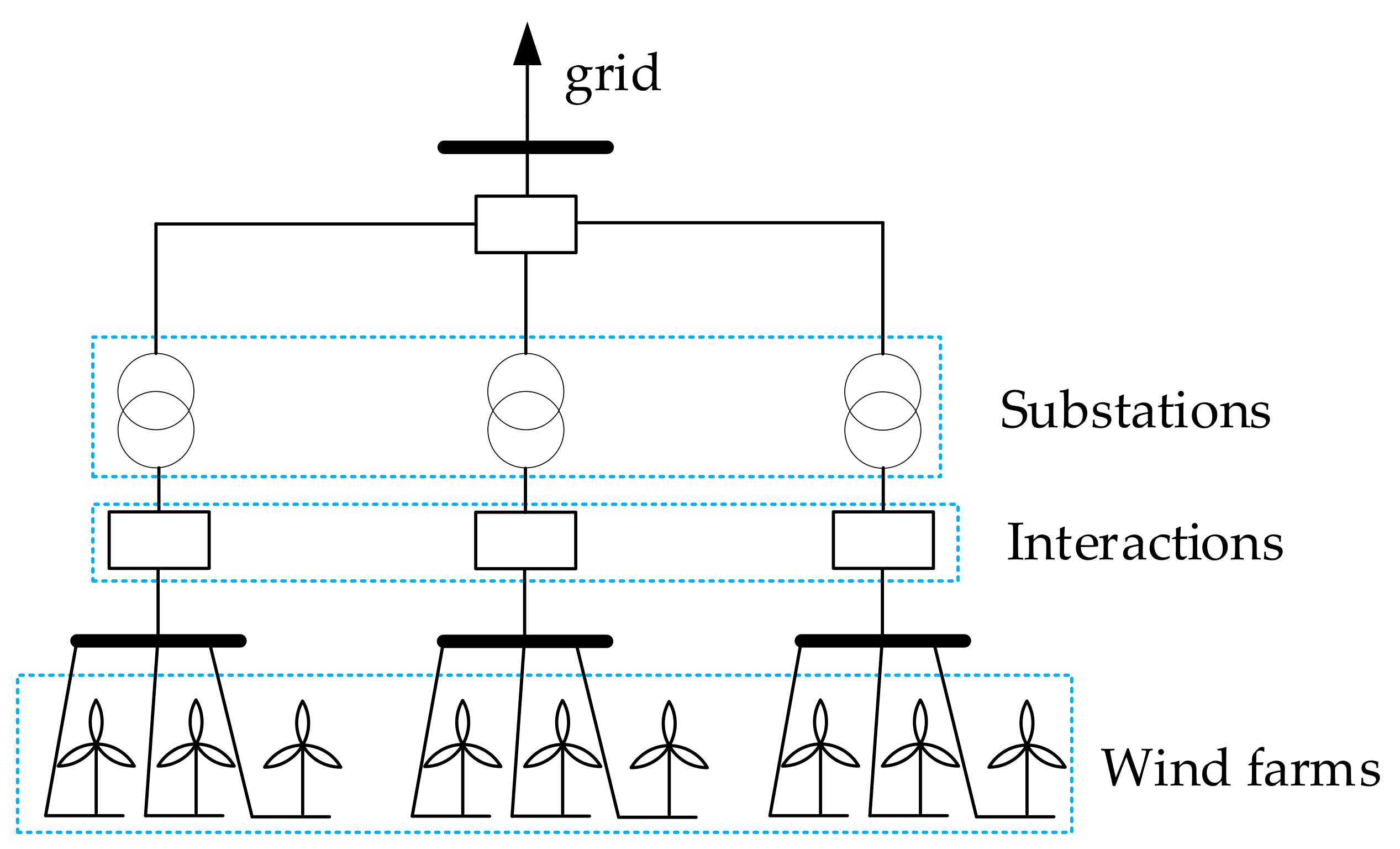
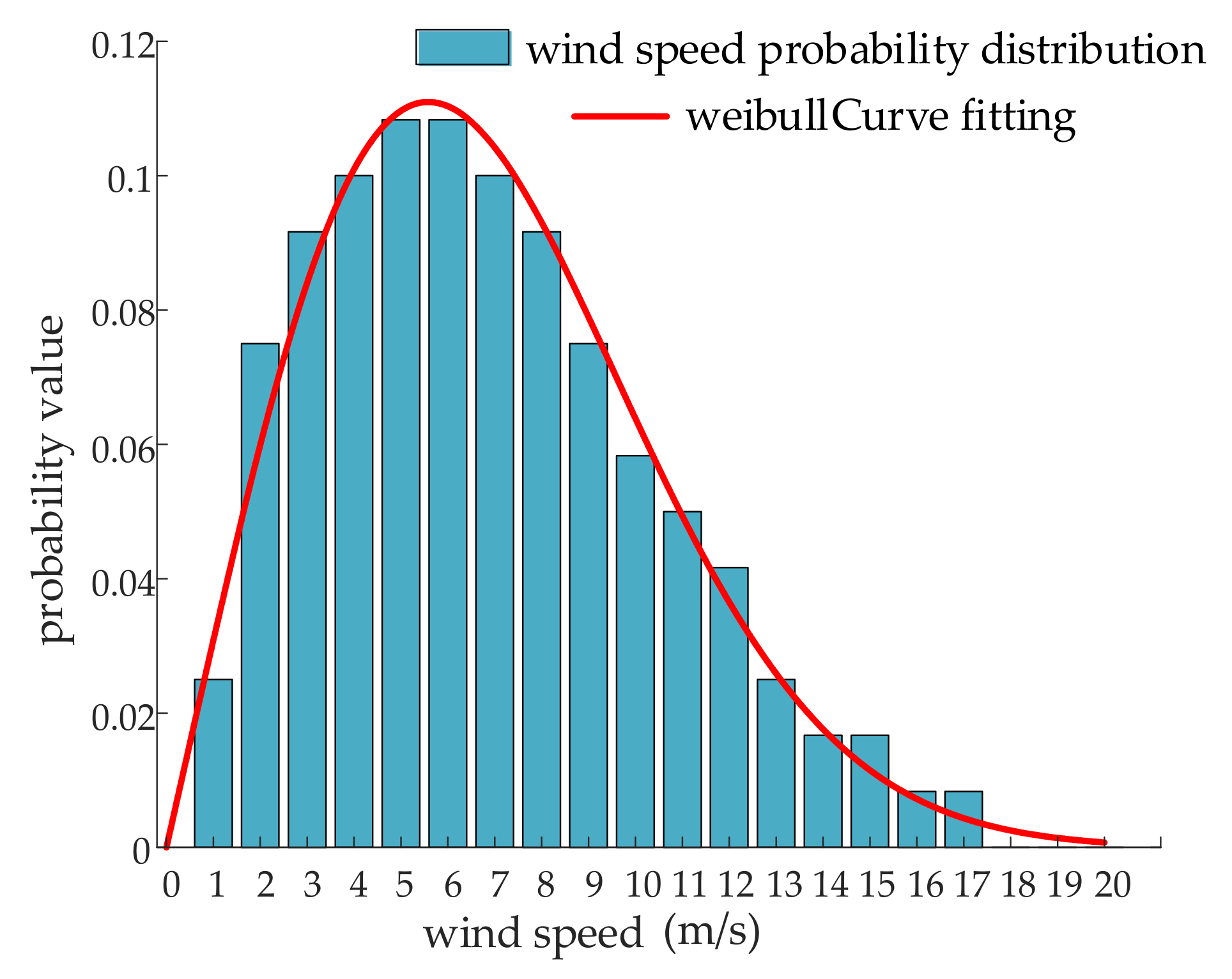
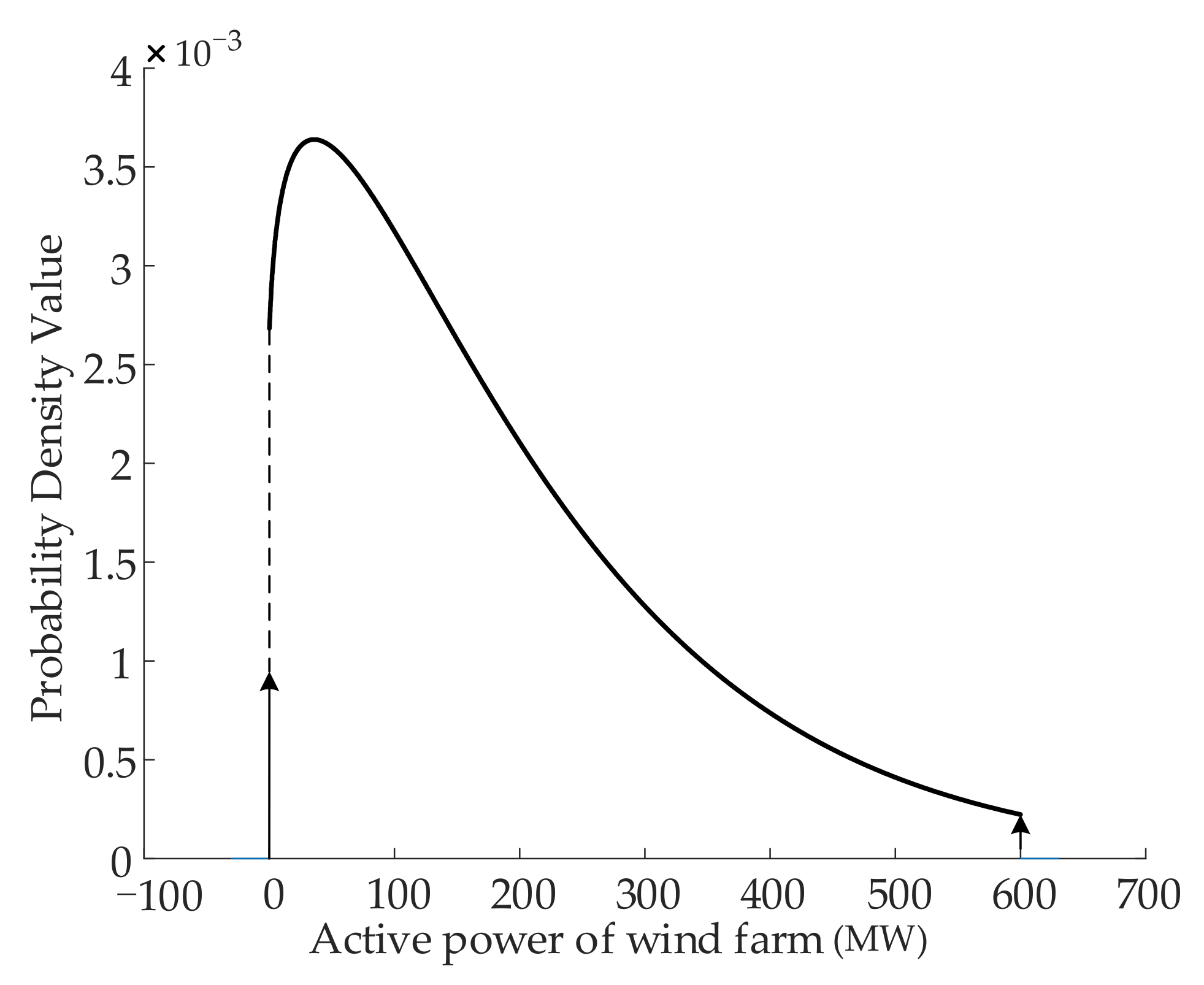
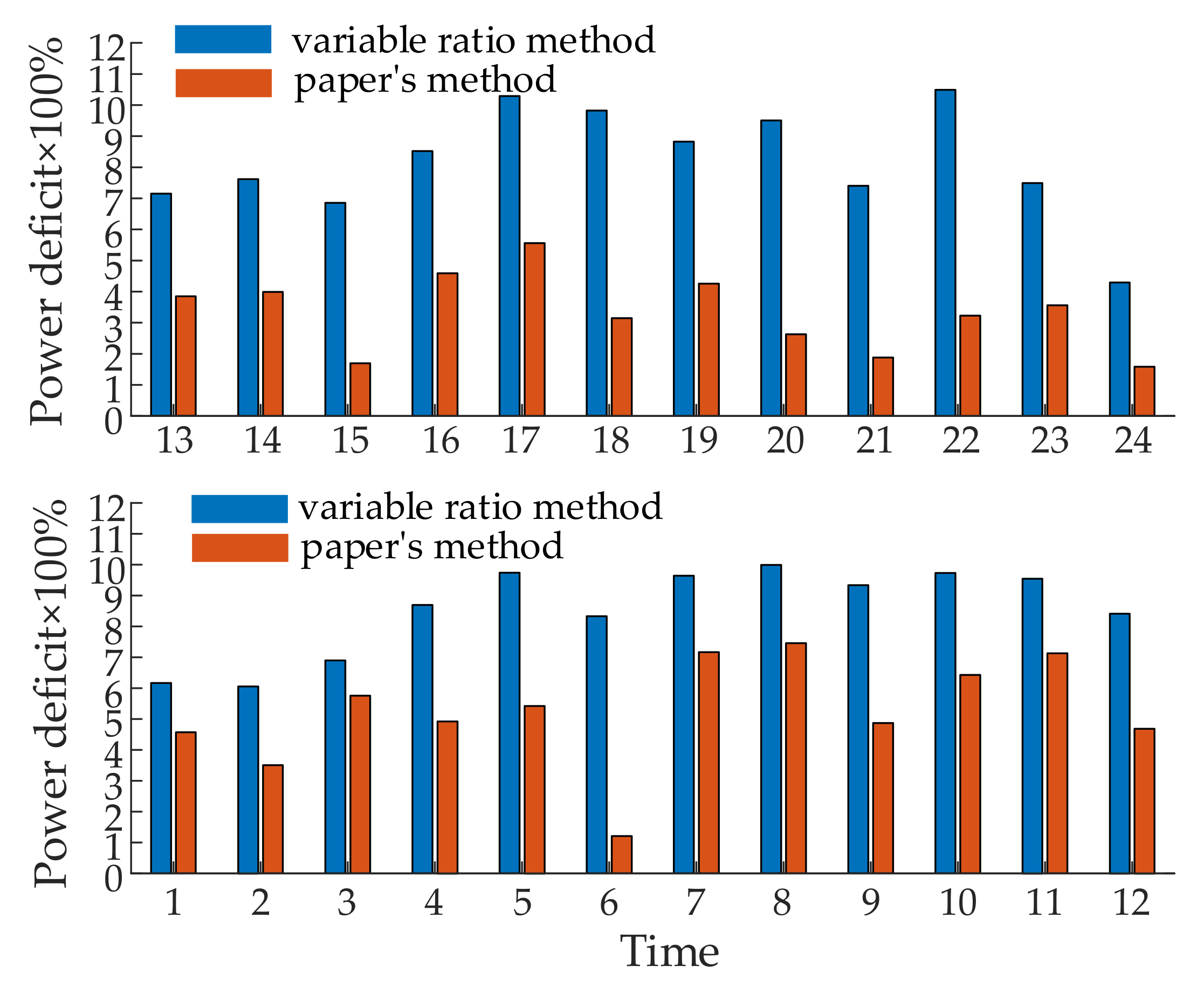
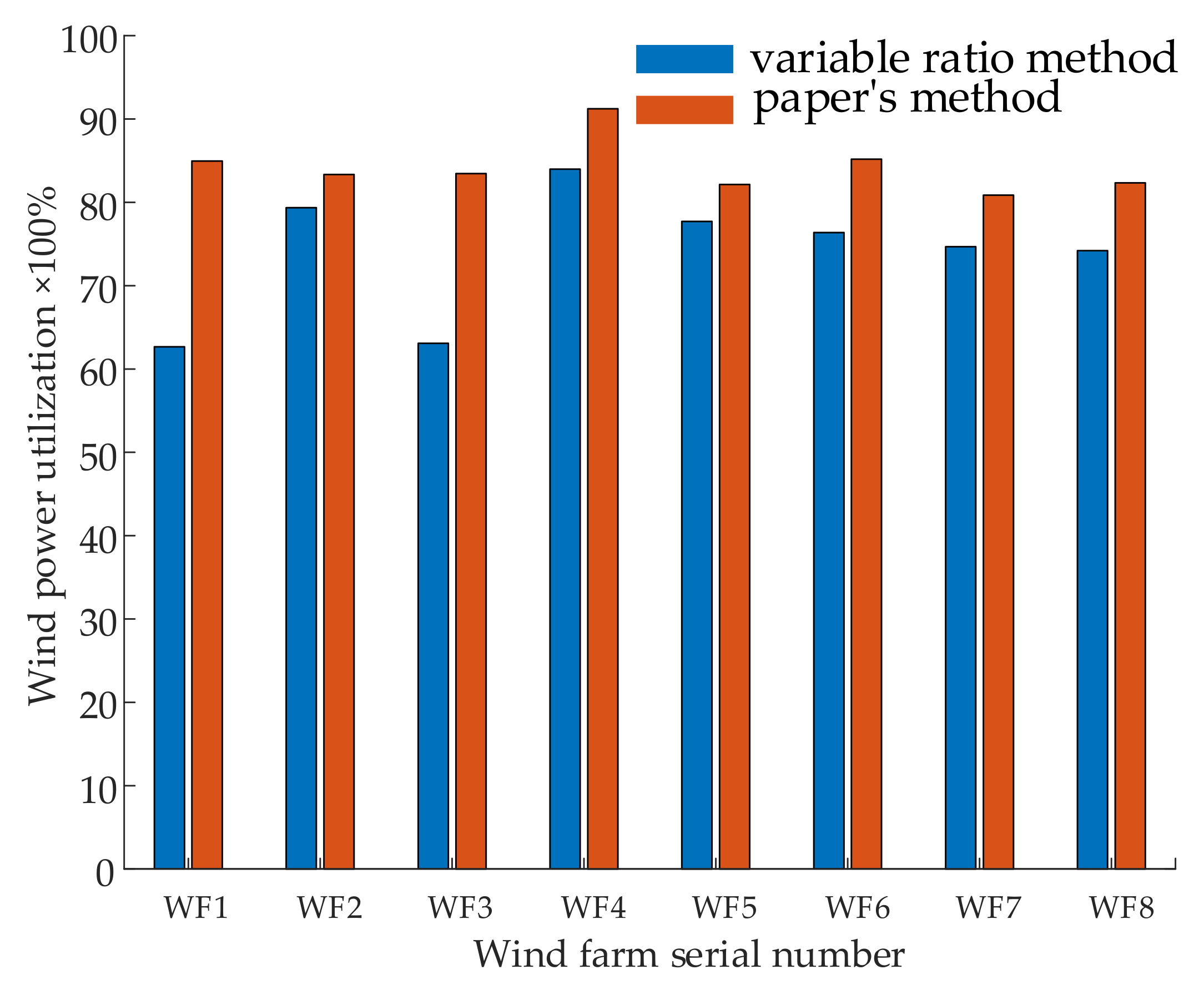

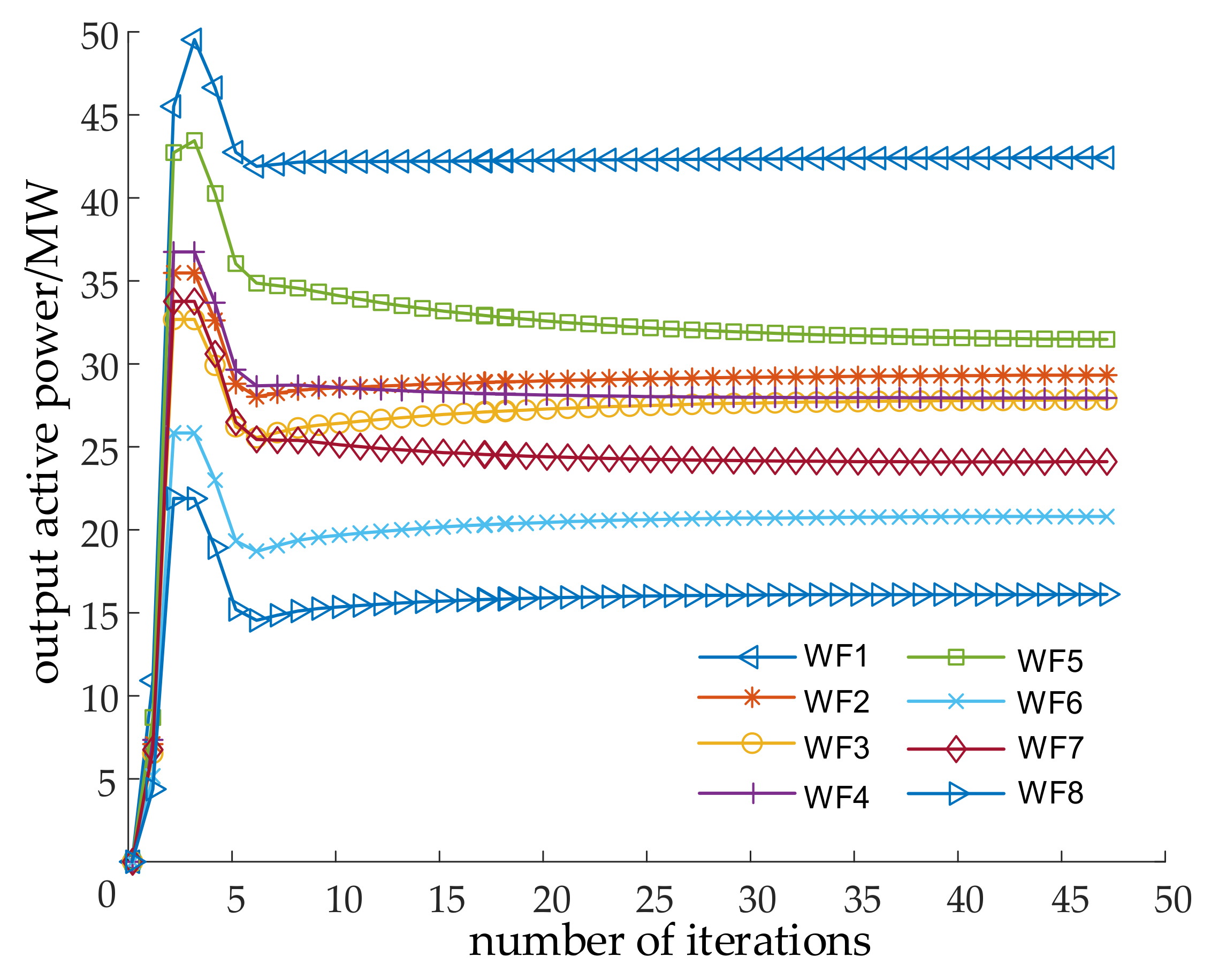

| Wind Farm | Capacity /MW | Wind Farm | Capacity /MW |
|---|---|---|---|
| WF 1 | 316 | WF 5 | 450 |
| WF 2 | 295 | WF 6 | 281 |
| WF 3 | 265 | WF 7 | 289 |
| WF 4 | 450 | WF 8 | 230 |
| WF | Solve Directly | ADMM | WF | Solve Directly | ADMM |
|---|---|---|---|---|---|
| 1 | 38.00 | 37.92 | 5 | 29.80 | 30.10 |
| 2 | 29.70 | 29.64 | 6 | 19.24 | 19.00 |
| 3 | 35.20 | 34.99 | 7 | 22.10 | 22.17 |
| 4 | 30.40 | 30.49 | 8 | 15.30 | 15.30 |
| Number of WF | Algorithm | Iterations | Calculate Total Time/s | Mean Iteration Time/s |
|---|---|---|---|---|
| 3 | centralization | 1 | 12.1 | 12.1 |
| distribution | 36 | 188.6 | 6.5 | |
| 8 | centralization | 1 | 59.3 | 59.3 |
| distribution | 47 | 236.1 | 6.8 | |
| 12 | centralization | 1 | 243.6 | 243.6 |
| distribution | 54 | 378.0 | 7.0 | |
| 16 | centralization | 1 | 458.9 | 458.9 |
| distribution | 61 | 433.1 | 7.1 |
Publisher’s Note: MDPI stays neutral with regard to jurisdictional claims in published maps and institutional affiliations. |
© 2022 by the authors. Licensee MDPI, Basel, Switzerland. This article is an open access article distributed under the terms and conditions of the Creative Commons Attribution (CC BY) license (https://creativecommons.org/licenses/by/4.0/).
Share and Cite
Hong, P.; Qin, Z. Distributed Active Power Optimal Dispatching of Wind Farm Cluster Considering Wind Power Uncertainty. Energies 2022, 15, 2706. https://doi.org/10.3390/en15072706
Hong P, Qin Z. Distributed Active Power Optimal Dispatching of Wind Farm Cluster Considering Wind Power Uncertainty. Energies. 2022; 15(7):2706. https://doi.org/10.3390/en15072706
Chicago/Turabian StyleHong, Peizhao, and Zhijun Qin. 2022. "Distributed Active Power Optimal Dispatching of Wind Farm Cluster Considering Wind Power Uncertainty" Energies 15, no. 7: 2706. https://doi.org/10.3390/en15072706
APA StyleHong, P., & Qin, Z. (2022). Distributed Active Power Optimal Dispatching of Wind Farm Cluster Considering Wind Power Uncertainty. Energies, 15(7), 2706. https://doi.org/10.3390/en15072706






